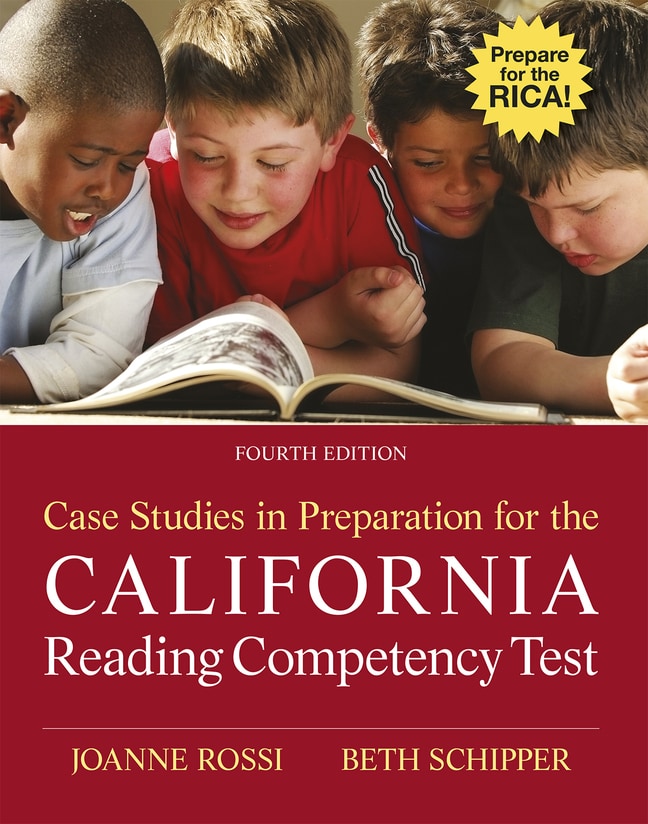
Case Studies in Preparation for the California Reading Competency Test, 4th edition
Your access includes:
- Search, highlight, notes, and more
- Easily create flashcards
- Use the app for access anywhere
- 14-day refund guarantee
$10.99per month
Minimum 4-month term, pay monthly or pay $43.96 upfront
Learn more, spend less
-
Study simpler and faster
Use flashcards and other study tools in your eTextbook
-
Listen on the go
Learn how you like with full eTextbook audio
-
Find it fast
Quickly navigate your eTextbook with search
-
Stay organized
Access all your eTextbooks in one place
-
Easily continue access
Keep learning with auto-renew
Overview
DOMAIN I: PLANNING AND ORGANIZING READING INSTRUCTION BASED ON ONGOING ASSESSMENT
Content Area 1: Conducting Ongoing Assessment of Reading Development
1.1 Principles of assessment
1.2 Assessing reading levels
1.3 Using and communicating assessment results
Content Area 2: Planning, Organizing, and Managing Reading Instruction
2.1 Factors involved in planning reading instruction
2.2 Organizing and managing reading instruction
DOMAIN II: DEVELOPING PHONOLOGICAL AND OTHER LINGUISTIC PROCESSES RELATED TO READING
Content Area 3: Phonemic Awareness
3.1 Assessing phonemic awareness
3.2 The role of phonemic awareness
3.3 Developing phonemic awareness
Content Area 4: Concepts About Print
4.1 Assessing concepts about print
4.2 Concepts about print
4.3 Letter recognition
Content Area 5: Systematic, Explicit Phonics and Other Word Identification Strategies
5.1 Assessing phonics and other word identification strategies
5.2 Explicit phonics instruction
5.3 Developing fluency
5.4 Word identification strategies
5.5 Sight words
5.6 Terminology
Content Area 6: Spelling Instruction
6.1 Assessing spelling
6.2 Systematic spelling instruction
6.3 Spelling instruction in context
DOMAIN III: DEVELOPING READING COMPREHENSION AND PROMOTING INDEPENDENT READING
Content Area 7: Reading Comprehension
7.1 Assessing reading comprehension
7.2 Fluency and other factors affecting comprehension
7.3 Facilitating comprehension
7.4 Different levels of comprehension
7.5 Comprehension strategies
Content Area 8: Literary Response and Analysis
8.1 Assessing literary response and analysis
8.2 Responding to literature
8.3 Literary analysis
Content Area 9: Content Area Literacy
9.1 Assessing content area literacy
9.2 Different types of texts and purposes for reading
9.3 Study skills
Content Area 10: Student Independent Reading
10.1 Encouraging independent reading
10.2 Supporting at-home reading
DOMAIN IV: SUPPORTING READING THROUGH ORAL AND WRITTEN LANGUAGE DEVELOPMENT
Content Area 11: Relationships Among Reading, Writing, and Oral Language
11.1 Assessing oral and written language
11.2 Oral language development
11.3 Written language development
11.4 Supporting English language learners
Content Area 12: Vocabulary Development
12.1 Assessing vocabulary knowledge
12.2 Increasing vocabulary knowledge
12.3 Strategies for gaining and extending meanings of words
Content Area 13: Structure of the English Language
13.1 Assessing English language structures
13.2 Differences between written and oral English
13.3 Applying knowledge of the English language to improve reading
Published by Pearson (July 14th 2021) - Copyright © 2012
ISBN-13: 9780137614912
Subject: Reading & Literacy
Category: Literacy Methods (K-8)
Your questions answered
When you purchase an eTextbook subscription, it will last 4 months. You can renew your subscription by selecting Extend subscription on the Manage subscription page in My account before your initial term ends.
If you extend your subscription, we'll automatically charge you every month. If you made a one‑time payment for your initial 4‑month term, you'll now pay monthly. To make sure your learning is uninterrupted, please check your card details.
To avoid the next payment charge, select Cancel subscription on the Manage subscription page in My account before the renewal date. You can subscribe again in the future by purchasing another eTextbook subscription.
When you purchase a Channels subscription it will last 1 month, 3 months or 12 months, depending on the plan you chose. Your subscription will automatically renew at the end of your term unless you cancel it.
We use your credit card to renew your subscription automatically. To make sure your learning is uninterrupted, please check your card details.